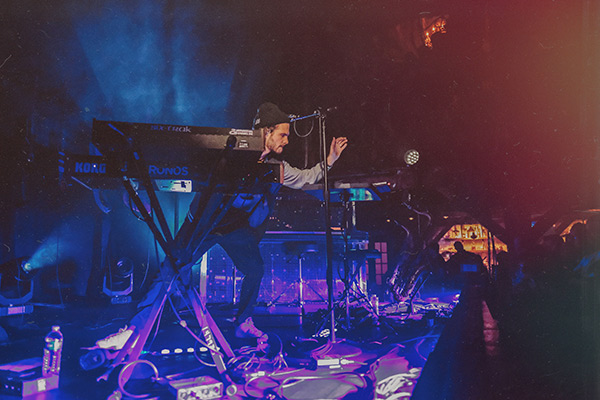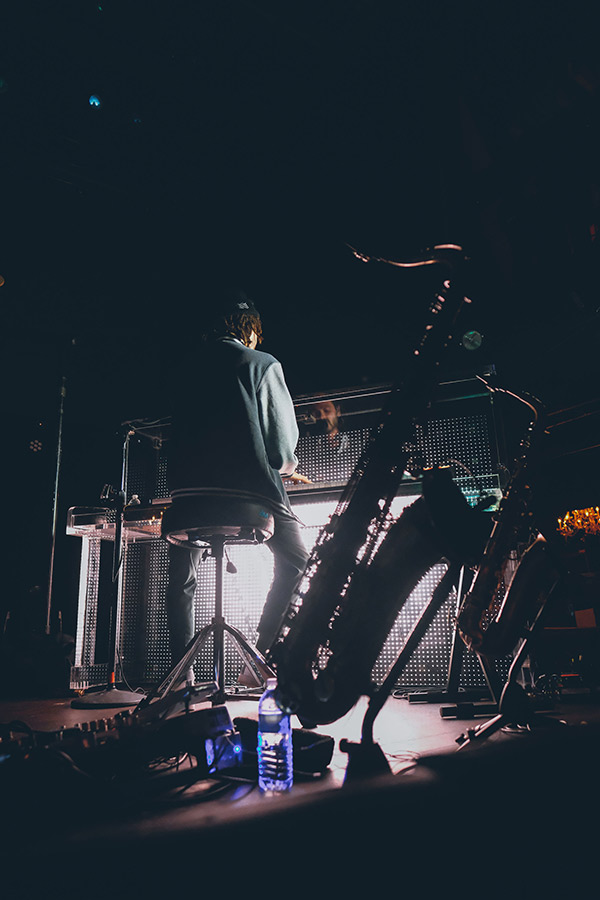FKJ’s Theories of Everything
Words by Daniel Joey Oakley / Photos by Mary Katherine Leslie-Van-Hook
Festival season in New Orleans means nosefuls of night-blooming jasmine, vomit on Bourbon Street, and mud indistinguishable from horseshit at the fairgrounds racecourse. When the crowds leave Fest and Mid City, they hit the grids: color-coded cubes of aftershows, where the avant-garde can be found.
French language is so embedded here that it slips right by. The pronunciations are bastardized, and deploying a Parisian accent will highlight you as a tourist. But tonight, thousand-person capacity Republic NOLA has been sold out by one groove ambassador from the city of Tours in Western France.
The line is already long. Loyalists have eschewed Frenchmen Street for the relative purgatory of the warehouse district and a genre noone can seem to define. Years ago Vincent Fenton, the man, conceived French Kiwi Juice, the experience. “FKJ’s” mum is de la République Française, his father New Zealand (a Kiwi).
Fenton had been composing on guitar and piano for years when he enrolled to study audio engineering for film. Sound design led to electronic music in Paris, where house was dominant. FKJ was born. He was DJing, had released an EP ‘Twins’ (2012) and was nearly relegated to turntablist, when he began playing live sets. The young man was a triple-threat producer: programmer, arranger, and, he reminded folks--instrumentalist.
Watch FKJ play an exclusive live set on the world's largest salt flat.
The crowd converging on Republic is diverse by every measure. Thirty-somethings swig whiskey from the trunk. An older woman in an elegant gown--Louisiana plates--hurries in. Gender-fluid, surely fake-ID’d teens strut their peach fuzz and snapbacks. Vapes are preferred to cigarettes. One gaggle of beards speaks actual French.
Inside, it is impossible to edge to the front of even the VIP balconies, let alone the floor. The 50th annual Jazz and Heritage Festival has shown up in force with free energy. Girls wear bandanas for shirts, still dusty from the track. Jazzdads don kilts and part the crowd with their deadhead sons.
They have a lot of explaining to do. The Frenchman of few words has tended to speak through his instruments, and most concertgoers seem led by a devotee proselytizing to their friends. When hoots and hollers go up for Lou Phelps, the opener, one guy think he’s FKJ.
Phelps asks the crowd, “Do you like hip-hop?” and plays A Tribe Called Quest from a standard Pioneer CDJ. Behind him is the rig he’ll use none of: two guitars, a bass, a keyboard, an upright piano, sibling saxophones, and a vast array of pedals and digital controllers.
Phelps is the brother of Kaytranada, a Haitian-Canadian producer and DJ noted for his work with fellow genre-bender Anderson .Paak--and for making bleep-blorps human. It’s a lineage descended in part from J Dilla, who humanized the MPC (Midi Production Center), the original backbone of beatmaking for rap and dance music.
Thoroughly flummoxed, then, are most as to what to expect. Phelps finishes his just-DJ set. The cracks in the crowd seal up. One excited conversation is about how the definition of ‘jazz’ is loosened for ‘Jazzfest.’ Here in its birthplace,‘jazz’ is sometimes used to mean any live improvisation.
“The cracks in the crowd seal up. One excited conversation is about how the definition of ‘jazz’ is loosened for ‘Jazzfest.’ Here in its birthplace,‘jazz’ is sometimes used to mean any live improvisation.”
Think of it this way: Rap showgoers couldn’t care less whether someone is noodling a six-string. By contrast, jamband kids would walk out if someone switched on tracked drums, regardless who programmed them. So which audience are we? Or is the first fusion of the night simply each of us - mashed up with each other?
The truth is that as pop giant Mark Ronson said in his TED talk, we are in the post-sampling era. The 808 drum machine itself--the sound of innumerable grooves--began as a malfunction at Roland, where lab techs knew that the immensely satisfying boom was not reproducible by an actual drum, no matter the dimensions: its acoustics did not exist in physics.
The lights go. The smoke comes up. People dip pinkies in baggies. And FKJ takes the stage. We have long ago crossed over into the physically impossible.
FKJ says New Orleans like we do. OR-luns, rather than Orléans, the capital of his Centre-Val de Loire.
The man makes beats, and he demonstrates the steps by way of introduction. Brow furrowed under a beanie, he loops handclaps in jaunty syncopation, beatboxes over it, adds a guitar riff, and faster than the eye can follow, there is a fully formed song but for the--he grabs his bass--and drops the beat.
With a stomp of clean Adidas on a footswitch mapped to MIDI, drums crafted some time ago send hands in the air. FKJ’s own fingers fly about his four-string electric bass. His funk is hard. Angular. Swinging. His dreadlocks bounce. The almost-slap technique owes as much to George Porter Jr. and New Orleans’ own Meters as the atmospherics do to film scoring and EDM.
‘Is Magic Gone’ opens into soaring, reverb-drenched guitar, recalling John Frusciante. FKJ flits over to what appears to be a crystal light piano, dropping bizarre jazz chords in effortless 9ths, 13ths, 11ths, moving into another single, ‘TUI’. What sounds like a concert grand is one of two massive keyboard workstations, synthesizers patched to taste, and the clear frame, studded with LEDs like a Lite-Brite, is only a lucite case the shape of a Steinway.
It is now that you begin to become skeptical. Who is he to master so much, while the rest of us flounder in order?
FKJ cuts the drums and goes chillwave, leaving the wah-pedaled bass. He picks up a tenor saxophone, hits a pad, switches to the alto sax, then harmonizes with the loop and locks it in. He refuses to stay put it in a genre, in an energy, or in a beat, let alone in one place on stage. He will unite the clans. He unbuttons his NASA baseball jacket, and promises orbit.
With the freedom to ride a pure musical idea, unencumbered by other musicians, FKJ takes flight in a rendition of ‘Leave My Home’. He is a starship of the imagination, he is frantically chalking up the blackboards - a Beautiful Mind formulae - encoded behind the glowing series of MKII controllers.
He is making love to perhaps his most native instrument, the synthesizer--a nine-engined Kronos--dialed into something sonically inorganic. The laser-firing, thruster-boost of the oscillators reminds you that nothing, can in fact, be not natural--least of all gear made by human sound designers.
There is a way FKJ works the paddle wheel, the pitch-bend shifter that makes the note cry like the blues, that has everyone in the room match his slightly pained expression. You can’t fake the funk, but you can fabricate the beautiful.
Friends sway. The strobes give way to blue mist. Someone wraps hands around a lover’s stomach.
FKJ has seen enough. Most songs have been extended vamps of their recorded versions. He slams into ‘Lying Together,’ a banger with the Oh, baby! sample everyone is soon chanting. He grabs the bass. He grimaces, methodically murdering the machine. The response this elicits?
“That is so filthy!” the crazed fan shouts. “You are so dirty!” And then to a confidant: “I love him.”
---
An argument both for and against electronic music is that it is ‘pure’. Does purity hold when imbued with such nastiness?
Vincent Fenton turns to rack his guitar, and suddenly has forgotten where to go next. It is a rare moment when the seams show. The drum fill rolls over too many times--the strobes are tied to repeating the visual of this would-be garnish--while its orchestrator searches a menu screen, scanning the rack-mounted controller, and for a second the matrix peels up at the edges.
FKJ springs into action, lunging for a button, and makes a diving grab in time to catch the bar, the musical phrase intact. He is back to pouring an almost private grimace into his conducting. You are watching both the intimacy of writing and the theater of virtuosity. As Prince’s engineer Susan Rogers said of The Artist in her Ableton LOOP talk: Doing everything yourself magnifies idiosyncrasy. It ensures a flawlessness of concept. It relinquishes no control.
As for FKJ, maybe singularity is as close to unimpeded energy-transfer as we get. That’s what live music is about. That’s what jazz--in the New Orleans lexicon--is.
After soloing over some premade beats “for fun”, FKJ returns to his crystal piano. It is a lightspeed proficiency that conjures the almost haplessness of James Booker.
“Thank you New Orleans,” he says, like we say it. “I love you. This is my last song.”
He grabs the guitar.
“I can’t get any closer!” someone yells.
He starts the riff for which he is best known.
“This is the reason I’m here right now!”
With the lick tracked, FKJ hits the the riff for which he is second-best known. He harmonizes his two saxophones, standing in for the co-creator of the song.
TADOW!
The voice of Masego pipes in, across the unseen miles and through time irrelevant. FKJ’s collaborator is the cosigner of both artists’ biggest song. The viral video of the two men bouncing around the studio is responsible for much of the audience (130-million views).
Not only does no one care that Masego is not ‘here’. They praise that he ‘is’! Perhaps some of those reveling in his singing over FKJ were those who commented: ‘The future of music’. The fusion is the forefront. And it was DJ Jazzy Jeff who said of the drums in a clip: “We gotta make ‘em knock.”
Everyone points their phone screens at FKJ layering his horns. How long until ‘live’ performance is just an injection of code into the neurons? Synapses are already an electrical field. Masego embraced this a different way, bringing down the House of Blues last fall with a full band and backing tracks. Here, his contemporary FKJ has chosen the bodiless hive of the one, the everything of nothing, and tells us: You can have it all.
He stabs the synth, makes it weep, he leaks robot juice, the sine wave goes wobbly in the knees and preaches universal language. It is going on behind his slightly pained eyes, as all good love is a little hard of seeing.
The lights go up. The missed connections search for each other. Out into the noir de la nuit, the smokers cling by the bus. The talk is that Howlin Wolf next door will have funk all night: “Skerik, Vidacovich, Deitch, all those guys.”
Propositions go answered. Some have work tomorrow. Some make for the funk. Some run into those they used to run hard with.
“It’s a different age!” I say.
“A different age,” she agrees fondly.
There are mornings when you can smell the ocean from the Mississippi river, the Gulls crying updraft of the Gulf, where three centuries ago the French shipped home spoils from the Mouth de Louisiane. That was then. This is now, when FKJ has proven time and distance illusory.
He has sung us on home. Some on til’ dawn. All unto the salt sea of rising stars.
—
Daniel Joey Oakley is an author and total space cadet. He is the founder of roving Hip-Hopera DOJO KEEN.
Mary Katherine Leslie-Van-Hook is a freelance photographer and creator of the Muse Rebellion lifestyle boudoir project for women. She can probably whistle ‘Pomp and Circumstance’ better than you.






